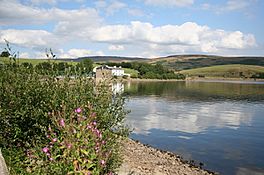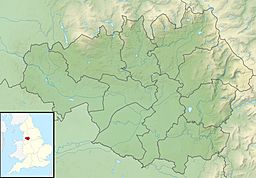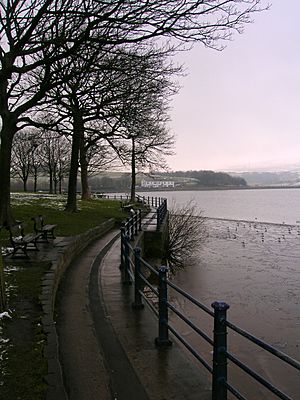Hollingworth Lake facts for kids
Quick facts for kids Hollingworth Lake |
|
|---|---|

The lake from the north shore
|
|
| Location | Littleborough, Greater Manchester |
| Coordinates | 53°37′50″N 2°05′47″W / 53.630618°N 2.096415°W |
| Primary inflows | Longden End Brook |
| Primary outflows | Hollingworth Brook |
| Basin countries | England |
Hollingworth Lake is a large lake, about 130-acre (53 ha) in size. It's located near Smithy Bridge in Littleborough, which is part of Greater Manchester, England.
This lake was first built to supply water to the Rochdale Canal. But soon, in the 1860s, it became a popular holiday spot. People even called it the Weighver's Seaport! Hotels were built around the lake, and some even had outdoor dancing areas with gas lights. Getting to the lake was easy thanks to the railway, which started bringing visitors from Manchester, Bradford, and Leeds in 1839.
The lake's popularity as a resort slowed down in the early 1900s. During the First World War, the area was even used as an army camp. In 1923, the canal company sold the lake to local authorities for water supply. After the Second World War, Rochdale Council bought the boating rights. They turned the area into the Hollingworth Lake Country Park in 1974. Since then, more and more things to do have been added. Today, it's a busy place for water sports and other fun activities.
Did you know that Captain Matthew Webb trained at Hollingworth Lake? He was the first person to swim the English Channel in 1875! The lake also hosted the "World Professional Mile Championship" for long-distance swimming in the 1880s. The Hollingworth Lake Rowing Club has been here since 1872 and is still going strong.
Contents
Building the Lake: A Big Project
The idea for the Rochdale Canal was approved in 1794. Hollingworth Lake was built as a main water source for it. The lake was finished in 1800, four years before the canal itself.
The lake covers about 130 acres (53 ha). The path around it was originally 2.5 miles (4 km) long. The lake is about 25 feet (7.6 m) deep in some places, with an average depth of 10 feet (3.0 m). When it was first built, it could hold 400 million gallons (1,800 Ml) of water!
The area wasn't naturally a good spot for a reservoir. So, three large earth walls, called embankments, had to be built to hold the water.
- The main wall, Hollingworth Bank, is about 36 feet (11 m) high and 220 yards (200 m) long.
- Fens Bank is 30 feet (9 m) high and 220 yards (200 m) long.
- Shaw Moss Bank is 26 feet (8 m) high and 140 yards (130 m) long.
The lake's surface is about 557 feet (170 m) above sea level. A steam engine was once used to pump water 45 feet (14 m) high into a 4-mile (6.4 km) channel. This channel fed water into the highest part of the canal at Chelburn. The pumping engine was removed around 1910.
Local mill owners were worried the canal would take water from their mills. They tried to stop the canal from being built twice! The third time, the canal company promised to protect their water supply. This is why the lake was built in a way that didn't affect rivers like the River Roch. The lake, first called "The Lodge," helped some mill owners by supplying water to their mills. Houses were built for railway and factory workers. Soon, "The Lodge" became known as "The Lake" and was a popular place for walks.
Changes Over Time
By the 1920s, the Rochdale Canal was not doing well. In 1923, Hollingworth Lake and seven other reservoirs were sold to local authorities. They would use the water for public supply.
Major work was done in 1985 to make the earth dams stronger. The lake was closed for fun activities for almost a year during this time. In 2011, another inspection showed that the water outflow needed to be improved. This would allow water levels to be lowered faster in emergencies or after heavy rain. A new concrete tower was built, designed to blend in with the area. The lake's water level was lowered during this work, but it stayed open for water sports.
United Utilities is now in charge of maintaining the reservoir. Its main job is still to supply water to the Rochdale Canal. It has never been used to provide drinking water for people.
In 2020, a barrier was put in place to stop debris from blocking the overflow. The dams are regularly checked, similar to those at Whaley Bridge.
Hollingworth Lake: A Fun Tourist Spot
The area around Hollingworth Lake grew quickly after the Manchester and Leeds Railway arrived in 1839. The Summit Tunnel, the longest railway tunnel in Europe at the time, was built in 1841.
In the 1850s, Henry Newall, a local mill owner, saw the lake's potential for tourism. He leased the lake and added fun things to do, like boating. Even though the water was very cold, small rowing boats became popular. Two paddle steamers even started running in 1856. By 1860, there was a rowing club, and a regatta (boat race) was held in 1862.
Two hotels, the Beach Hotel and the Lake Hotel and Gardens, opened for visitors. Railway companies advertised the lake, bringing people to Smithybridge and Littleborough stations. From there, it was a short walk to the lake.
The resort became known as the Weighver's Seaport. Guidebooks praised its beauty. One guide said: ..As you step on the embankment... the broad expanse of water at once presents itself to your vision. Your first feeling on beholding it is that of astonishment...
Hotels and Fun Activities
Before the reservoir, there were two inns: the Fisherman's Inn and the Blue Ball. The Beach Hotel was built early on, offering rooms and food. It had outdoor platforms with gaslight for parties and dancing. The Lake Hotel and Pleasure Grounds was built across the lake in a Swiss style. Visitors could walk, take a carriage, or cross by steamer. This hotel had a bowling green, a croquet lawn, and gardens.
Other inns like The Mermaid Inn and The Lodge Inn also offered food and rooms. The Queens Hotel, built in 1857, had a large pavilion and dancing stage. The Lancashire and Yorkshire Hotel, built in 1876, had a huge outdoor dancing platform. Many private houses also offered "tea in jugs and sandwiches." The resort was very popular, even hosting 6,000 miners for a conference in 1866.
At its peak in the late 1800s, there were three lake steamers. Visitors came by train from Manchester, Leeds, and Bradford. Fishing became popular after 30,000 fish were added in 1863. Stalls and shops sold sweets, snacks, and souvenirs. On special holidays, there were fortune tellers and tricksters. People could even get their photos taken. Other attractions included a camera obscura and a gymnasium. A roundabout with galloping horses stayed at the lake until after the Second World War.
The lake sometimes froze solid enough for ice activities. In 1860 and 1864, over 2,000 people skated. Teams from different cities played curling and even cricket on the ice. The lake also froze in 1902, 1907, 1924, 1929, 1941, and 1947. In 1934, the water level dropped so low that old farm buildings, not seen since 1800, became visible!
The resort got even more popular in 1883 when boats were allowed on Sundays. Huge crowds came to the lake. Swimming became popular, even in the cold water. This might have been inspired by Captain Matthew Webb, who trained here before his English Channel swim. Regular swimming competitions started in 1882, including the mile championship. A local man named Joseph Nuttall won the "World Professional Mile Championship" in 26 minutes and 8 seconds, watched by a crowd of 20,000!
Decline and Revival
By the early 1900s, travel became easier, and people started taking longer holidays. Hollingworth Lake's appeal began to fade. Some hotels closed, and the Beach Hotel burned down in 1901 (though it was rebuilt). Stunts and shows stopped. By the start of the First World War, the lake was in decline. There was a brief boost when a training camp for the Manchester Regiment was set up nearby. After that war, the rowing club grew, and the lake was used for sailing. Only the Fisherman's Inn and the Beach Hotel remained open.
In 1950, Rochdale Council took over the boating rights. They planned to turn the area into a country park, which happened in 1974. Ten years later, it was named one of the top ten country parks in England. Today, it's used for recreation and has a wildlife sanctuary. There are two public houses by the lake now: the Beach Hotel and the Wine Press (which used to be the Fisherman's Inn).
Activities at Hollingworth Lake
Hollingworth Lake is a great place for watersports! You can go sailing, windsurfing, canoeing, swimming, rafting, rowing, and fishing. Since 1989, the Hollingworth Lake Water Activity Centre has offered lessons in outdoor activities. These include kayaking, canoeing, power boating, and sailing. In summer, you can even rent rowing boats.
A new pleasure boat, The Lady Katherine, was launched in May 2019. It offers trips around the lake.
The scenic walk around the lake is about 2.5 miles (4.0 km) long. It passes a nature reserve with a bird hide in the south-western part of the lake. This area is kept clear of boats and watersports to protect the wildlife. The lake is home to many different animals and is used for fishing. More fish like carp, tench, and roach have been added to the lake.
The country park is also used for children's activities, like catching different types of pond life. The path around the lake is a gravel track for most of the way. A children's playground and an trim trail for adults were opened in 2010. These facilities were funded by the Big Lottery Community Spaces fund. The Friends of Hollingworth Lake, a group working to improve the area, helped make this happen.
Many groups use the lake:
- Hollingworth Lake Rowing Club: Their yearly regatta (boat race) has attracted many other clubs since 1964. The club started again in 1872 after an earlier break.
- Hollingworth Lake Sailing Club: Founded in 1946, they offer racing and casual sailing in different types of dinghy sailing boats.
- The Sea Cadets training centre "T.S. Palatine": This centre, opened in 1960, taught young people rowing, sculling, and seamanship. It closed in 2011, as the Sea Cadets decided to use a new centre elsewhere.
To the east, a visitor centre shows children's artwork and objects found in the lake. An annual Easter fun fair is held on a car park by the lake.
Getting to Hollingworth Lake
Hollingworth Lake is easy to reach!
- By Train: The lake is served by Smithy Bridge and Littleborough railway stations. You can travel west to Rochdale, Oldham, and Manchester, or east to West Yorkshire.
- By Bus: Buses from Rochdale, like the 455 and 456, go to Hollingworth Lake.
- By Car: It's easy to get to the lake from junction 21 of the M62 motorway. There are three pay and display car parks available.




